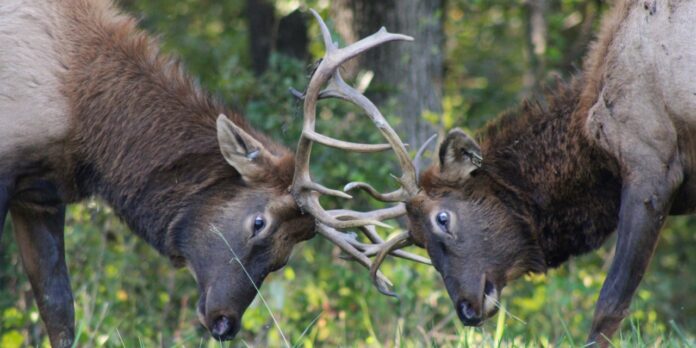Elk have been a staple at Kentucky’s Land Between the Lakes National Recreation Area for nearly three decades. Many of the area’s 1.8 million visitors per year come to see the herd at the Elk and Bison Prairie.
That herd is now a little smaller thanks to an agreement with the State of West Virginia, which received 43 elk from the recreation area to repopulate the species in the Mountain State.
The move, completed April 3, is a momentous one for West Virginia, but why would the USDA Forest Service agree to lose these beautiful animals?
While the loss does reduce the number of elk for visitors to view at Land Between the Lakes, wildlife biologists agree that the relocation is mutually beneficial for both locations.
“The 700-acre Elk and Bison Prairie can only support so many animals,” said Curtis Fowler, a Forest Service wildlife technician at Land Between the Lakes National Recreation Area in Golden Pond, Kentucky. “Reducing the number of animals increases the quality of our herd and makes them more resilient to stressors.”
The elk will have more natural forage and better cover to help raise new generations of elk for the future. This move also aligns with one of the original objectives of the project, namely to maintain a healthy population of elk for future wild reintroductions, wherever they are needed.
In fact, in the past 25 years, Land Between the Lakes National Recreation Area has helped release 168 elk into the wild, including reintroduction of elk to the Great Smoky Mountains National Park, as well as wildlife management areas in Kentucky and Tennessee.
The elk have been given a new home 400 miles east of the national recreation area at the Tomblin Wildlife Management Area in southern West Virginia. Land Between the Lakes sent two groups of elk to the state, supporting West Virginia’s efforts to reintroduce and expand the elk population.
According to the West Virginia Department of Natural Resources, translocating elk was the safest way to bolster numbers.
“The USDA Forest Service and Land Between the Lakes National Recreation Area have been an important part of the reintroduction efforts of elk back to West Virginia,” said Brett McMillion, director for the West Virginia Department of Natural Resources. “Since 2016, we have worked closely to bring 79 elk to the Tomblin Wildlife Management Area in Logan County. Their cooperation and assistance have been vital to the successes seen with the West Virginia elk reintroduction program.”
Back in Kentucky, the smaller herd will benefit from the extra elbow room. And not just the herd of elk. Fowler explained that many other animals make their homes in the prairie, and decreasing the population of our elk herd ensures smaller animals have quality natural materials available for nesting and cover.
Elk were first re-introduced to the area under the Tennessee Valley Authority’s management of the recreation area in 1996. The prairie was created to help demonstrate to visitors what native prairie land looked like when settlers arrived in Western Kentucky and Tennessee. Both elk and bison are native species that dwelled in the area that is now Land Between the Lakes.
 More than 75 elk from LBL have been released into the wild in West Virginia as part of the mutually beneficial agreement. (USDA Forest Service photo by Curtis Fowler)
More than 75 elk from LBL have been released into the wild in West Virginia as part of the mutually beneficial agreement. (USDA Forest Service photo by Curtis Fowler)
When the Forest Service assumed management of Land Between the Lakes in 1999, the herd consisted of approximately 35 elk. After the recent elk relocation to West Virginia, the herd now numbers 43. “We are proud to play a part in the success of elk reintroductions, bringing life back to the species as a manageable natural resource in multiple states,” said Fowler.

